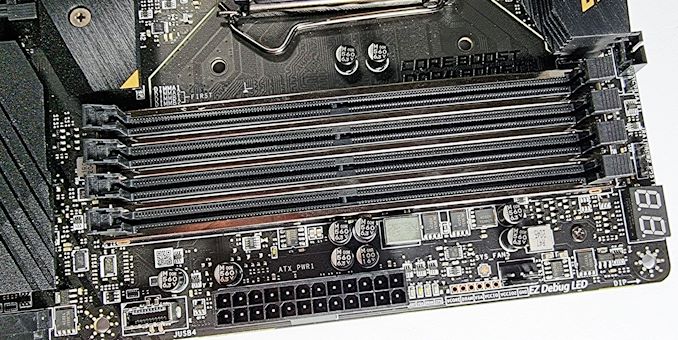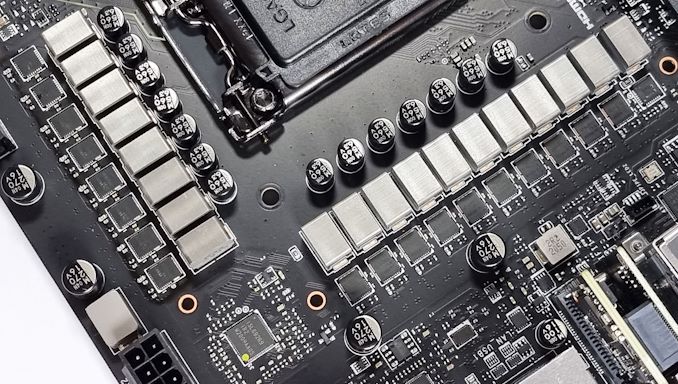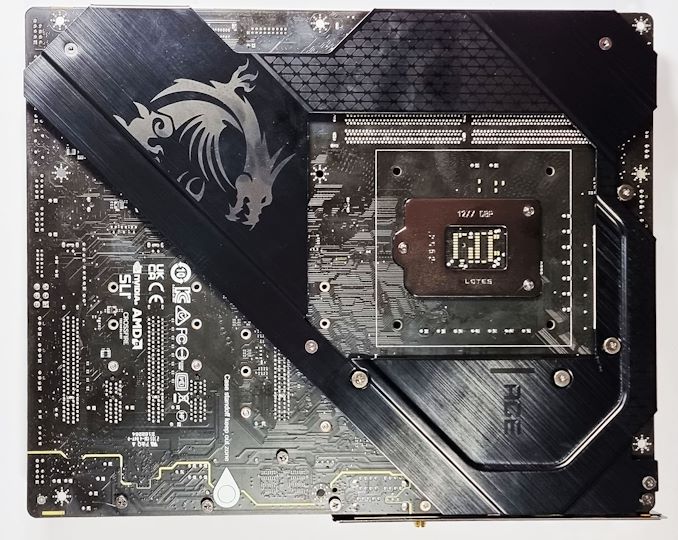MSI MEG Z590 Ace Motherboard Review: Premium Rocket Lake with TB4 and 4x M.2
by Gavin Bonshor on May 26, 2021 1:00 PM ESTVisual Inspection
Looking at the MSI MEG Z590 Ace visually, it is using an all-black color scheme with gold-colored text, which creates an accented look. From the top, the Ace has a large black rear panel cover that includes an affixed rear I/O panel, which sits over the CPU section of the power delivery heatsink. The rear panel cover itself includes an MSI Gaming dragon logo with integrated RGB LEDs which can be customized via the supplied software, and a carbon fiber section which adds contrast to the all-black design. Towards the center of the board is a wave of M.2 heatsinks which are amalgamated nicely into the design of the board with a matching chipset heatsink. Like the rear panel cover, the chipset heatsink also includes RGB LEDs. For cooling, the Ace includes eight 4-pin fan headers, with one dedicated for a CPU fan, one for a water pump, and six for chassis fans.
On the lower section of the board, the MSI MEG Z590 Ace includes three full-length PCIe slots, which each include metal slot reinforcement. The top two PCIe slots support PCIe 4.0 x16 or x8/x8, while the bottom full-length slot is electronically locked down to PCIe 3.0 x4. MSI includes a single 6-pin PCIe power connector which is designed to allow the PCIe slots to pull more power when overclocking graphics cards. In between the full-length slots is a pair of PCIe 3.0 x1 slots. In the top right-hand corner is a two-digit LED Debugger, with a power and reset button pairing located in the bottom right-hand corner. To the left of the buttons, are a pair of dip switches, one to enable or disable the RGB LEDs on the board, with the other allowing users to select between two BIOS chips.
For storage, MSI includes a total of four M.2 slots, with the top slot capable of supporting up to PCIe 4.0 x4, and the other three PCIe 3.0 x4, two of which also include support for SATA drives. At the lower right-hand side is a total of six SATA ports, with support for RAID 0, 1, 5, and 10 arrays. There is however some storage bandwidth restrictions on this board, which are as follows:
- SATA2 shares SATA bandwidth with M2_2, but PCIe drives are unaffected
- SATA5 and SATA6 share bandwidth with M.2_3, regardless of drive type
- When PCIe_5 (bottom full-length slot) is populated, M.2_4 will revert to PCIe 3.0 x2 instead of x4
In the top-right hand corner are a total of four memory slots, which include metal slot reinforcement with a single installation clasp at the top of each slot. In terms of support, the Ace can support a combined total of 128 GB, with a maximum supported speed of up to DDR4-5600, which is very impressive.
For the power delivery, MSI is using an 18-phase design which is controlled by an Intersil ISL69269 PWM controller. Focusing on the CPU section of the power delivery, there's a total of sixteen Intersil ISL99390 90 A power stages, while the SoC section is using two Renesas RAA220075 75 A power stages. The sixteen power stages on the CPU section paired in groups of two by eight Intersil ISL6617A doublers, which means the controller is operating at 8+2, eight channels for the CPU, and two for the SoC. This means the Ace can support a maximum output of up to 1440 A just for the CPU alone.
Keeping the power delivery cool is a pair of black metal heatsinks, which are interconnected via a single heat pipe. The heatsinks themselves feel quite weighty and have plenty of mass, with sections of deep fins that are designed to direct passive airflow to increase the heat dissipation capabilities of the heatsinks. Even the rear IO cover is attached, which should add some additional cooling properties to the heatsinks, and as the above image shows, the impressions of the thermal pads show the heatsink is making a good connection with the components.
Looking at the audio PCB, the Ace has Realtek's latest ALC4082 HD audio codec, with an ESS Sabre 9018Q2C digital to analog converter (DAC), which provides an extra element of quality to the audio specifications. Flanking the ALC4082 are eleven Japanese gold Nichicon audio capacitors, while the PCB itself employs a line of separation from the rest of the board's componentry. Interestingly, the cover used to hide the audio PCB is made from metal, and MSI looks to have done away with plastic covers and gone for a more premium feeling board. Something we applaud on a premium model such as this.
On the backside of the board is a large backplate, which adds both rigidity and some additional cooling properties to the rear of the power delivery. This includes a pair of thermal pads behind the power delivery sections, with a diagonal-shaped cutout behind the PCIe slot area.
The rear panel includes a premium selection of input and output, including two Thunderbolt 4 Type-C ports, with two mini-DisplayPort video inputs for the Thunderbolt 4. Other USB connectivity includes two USB 3.2 G2 Type-A, four USB 3.2 G1 Type-A, and two USB 2.0 ports. On the far left of the panel are a Clear CMOS and BIOS Flashback button pairing, while on the other side are five 3.5 mm audio jacks and S/PDIF optical output powered by a Realtek ALC4082 HD audio codec and ESS Sabre 9018Q2C DAC combination. The networking capabilities include a single Intel I225-V 2.5 GbE controller, with wireless capability and BT 5.2 connectivity coming from an Intel AX210 Wi-Fi 6 CNVi. Finishing off the rear panel is a single HDMI 2.0b video output.
What's in The Box
Some of the most notable accessories within the large bundle include four SATA cables, a DisplayPort to mini-DisplayPort cable, four M.2 screw installation kits, a user manual, a quick installation guide, a USB drive containing drivers and software, with an Intel AX210 Wi-Fi 6E antenna and cool little cleaning brush.
- User manual
- Quick installation guide
- Reward/Shout out flyer
- Cable sticker sheet
- MEG Sticker sheet
- Case badge
- Product catalog
- Warranty registration card
- Intel AX210 Wi-Fi 6E antenna
- Cleaning brush
- 2 x Screwdrivers
- 4 x SATA cables
- DP to mini-DP cable
- Thermistor cable
- RGB LED splitter cable (1 to 2)
- MSI RGB LED extension cable
- Corsair RGB LED extension cable
- 4 x M.2 installation screws


















11 Comments
View All Comments
TheinsanegamerN - Wednesday, May 26, 2021 - link
That's a LOTTA money for a motherboard without 10Gbe and limited to either 10 coffee lake cores or 8 rocket lake cores.YB1064 - Thursday, May 27, 2021 - link
Yes, I agree. No 10GbE in a premium board = no buy!ballsystemlord - Thursday, May 27, 2021 - link
I also agree. I can't order even 0.5G Ethernet but I defiantly need that 10GbE port!lmcd - Friday, May 28, 2021 - link
Aside from defiantly being unable to spell, the point of 10G Ethernet is connection to a local NAS, among other things.kpb321 - Wednesday, May 26, 2021 - link
The Mini DP in for supporting the USB-C display port alt mode with a discrete video card has always felt like a pretty clunky solution. That's why I've always felt like that was much more useful on laptops, SFF etc where there is no support for changing a dedicated GPU and you just build that into it. I wonder if they could built Display port signaling into the PCI-E slot using some reserved pins or an extra section of connectors or something like that to make it simple with a dedicated GPUTheinsanegamerN - Wednesday, May 26, 2021 - link
You can already do video signaling through PCI-E. That's how laptop GPUs have worked ever since the first iterations of optimus.Jorgp2 - Thursday, June 3, 2021 - link
Pretty sure it's actually built into windows nowadays.damianrobertjones - Thursday, May 27, 2021 - link
"with a flagship motherboard model costing nearly double that. It comes down to..."Greed.
Questor - Thursday, May 27, 2021 - link
All this connectivity and still a shortage of PCI express lanes.GNUminex_l_cowsay - Thursday, May 27, 2021 - link
I think the next high end motherboard review needs to have a feature comparison table. Post time and idle power are impossible to interpret without knowing what is on the board and these high end boards have a lot of things.